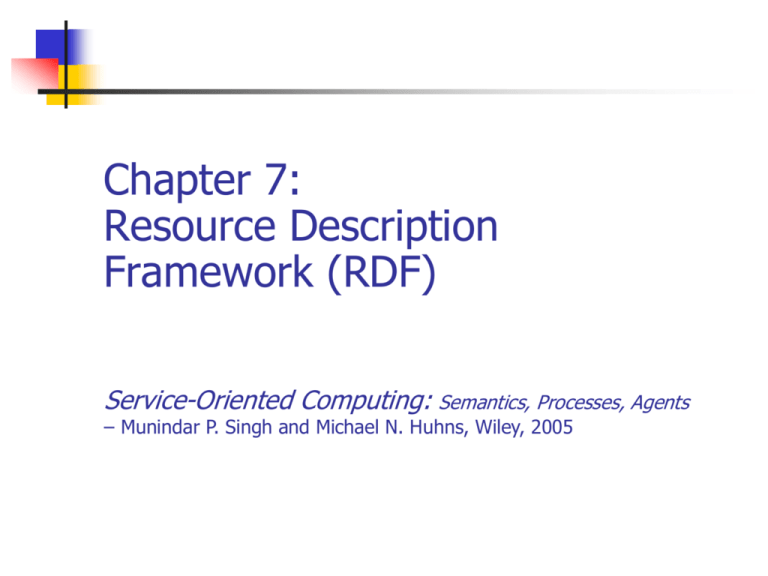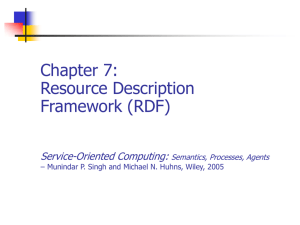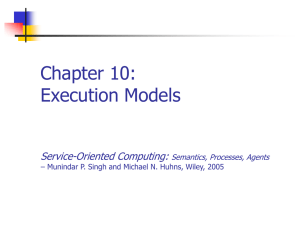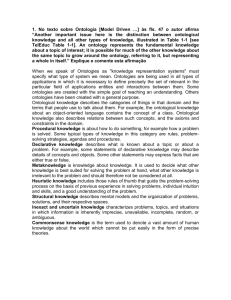Chapter 7: Resource Description Framework
advertisement

Chapter 7: Resource Description Framework (RDF) Service-Oriented Computing: Semantics, Processes, Agents – Munindar P. Singh and Michael N. Huhns, Wiley, 2005 RDF A basis for knowledge representation Simple language to capture assertions (statements) Elements of knowledge about a resource Facilitate incremental acquisition of knowledge Consolidates old KR ideas Supports inferencing Frames, OO modeling Applies URIs to clarify meanings and handle vocabulary differences Chapter 7 Service-Oriented Computing: Semantics, Processes, Agents - Munindar Singh and Michael Huhns 2 Why RDF? Whereas XML Gives us a document tree Doesn’t identify the content represented by a document, where content means Chapter 7 Concepts the document is about Relationships among them Enables multiple representations for the same content RDF expresses the content itself Service-Oriented Computing: Semantics, Processes, Agents - Munindar Singh and Michael Huhns 3 Resources and Literals RDF captures descriptions of resources A resource is an “addressable” object A literal is something simpler Chapter 7 Of which a description can be given Identified via a URI Worth talking about and possible to talk about A value, e.g., string or integer Cannot be given a description Service-Oriented Computing: Semantics, Processes, Agents - Munindar Singh and Michael Huhns 4 Statements or Triples RDF is based on a simple grammar Each statement consists of Chapter 7 An RDF document is simply a set of statements also known as triples Subject: a resource Object: a resource or a literal Predicate: a resource Comes with RDFS, a vocabulary to create vocabularies Service-Oriented Computing: Semantics, Processes, Agents - Munindar Singh and Michael Huhns 5 Rendering RDF RDF is not about the surface syntax but about the underlying content Using the XML serialization of RDF RDF is not tied to XML Standard XML namespace syntax Namespaces defined by the RDF standard Chapter 7 Typically abbreviated rdf and rdfs Service-Oriented Computing: Semantics, Processes, Agents - Munindar Singh and Michael Huhns 6 Example in XML (Using Dublin Core) <?xml version='1.0' encoding='UTF-8'?> <rdf:RDF xmlns:rdf="http://www.w3.org/1999/02/22-rdf-syntax-ns#" xmlns:dc="http://purl.org/dc/elements/1.1/"> <rdf:Description rdf:about="http://www.wiley.com/SOC"> <dc:title>Service-Oriented Computing</dc:title> <dc:creator>Munindar</dc:creator> <dc:creator>Michael</dc:creator> <dc:publisher>Wiley</dc:publisher> </rdf:Description> </rdf:RDF> rdf:Description gathers statements about one subject Distinguish rdf:ID from rdf:about Chapter 7 Service-Oriented Computing: Semantics, Processes, Agents - Munindar Singh and Michael Huhns 7 Example in N-Triples Notation Subject-Predicate-Object <http://www.wiley.com/SOC> <http://purl.org/dc/elements/1.1/title> "Service-Oriented Computing" . <http://www.wiley.com/SOC> <http://purl.org/dc/elements/1.1/creator> "Munindar" . <http://www.wiley.com/SOC> <http://purl.org/dc/elements/1.1/creator> "Michael" . <http://www.wiley.com/SOC> <http://purl.org/dc/elements/1.1/publisher> "Wiley" . Could also write individual statements in the XML syntax, but the rdf:Description element simplifies the notation Chapter 7 Service-Oriented Computing: Semantics, Processes, Agents - Munindar Singh and Michael Huhns 8 Exercise Graphs represent binary relationships naturally Express a three-party relationship Chapter 7 The vendor ships SKU-99 The vendor ships SKU-99 quickly Hint: think of gerunds from natural language grammar Service-Oriented Computing: Semantics, Processes, Agents - Munindar Singh and Michael Huhns 9 Multiparty Relationships An edge has two terminals, so limited to binary relationships To represent a multiparty relationship, introduce a resource corresponding to the relationship itself Chapter 7 That’s what a gerund does in NL Analogous to an association entity Include edges originating or targeting this resource Service-Oriented Computing: Semantics, Processes, Agents - Munindar Singh and Michael Huhns 10 Exercise Express a quotation Hint(?): In RDF, we can only talk about resources Chapter 7 Alice says the vendor ships SKU-99 And literals, but literals are points of last resort Service-Oriented Computing: Semantics, Processes, Agents - Munindar Singh and Michael Huhns 11 Reification of Statements Reify: to make referenceable, essential for quoting statements to Make a statement into a resource; then talk about it Chapter 7 Agree or disagree with them Assert modalities: possible, desirable, … rdf:Statement is the class whose rdf:type the given statement (object) is; additional properties such as rdf:subject, rdf:object, and rdf:predicate Service-Oriented Computing: Semantics, Processes, Agents - Munindar Singh and Michael Huhns 12 RDF Schema Analogous to an object-oriented type system built on top of RDF. Defines Chapter 7 rdfs:Class, rdfs:subClassOf rdfs:Resource, rdfs:Literal rdfs:Property, rdfs:subPropertyOf rdfs:range, rdfs:domain rdfs:label, rdfs:comment, rdfs:seeAlso Applications of RDF Schema deferred to OWL, which greatly enhances the above Service-Oriented Computing: Semantics, Processes, Agents - Munindar Singh and Michael Huhns 13 RDF Schema versus XML Schema Both help define custom vocabularies An XML Schema document gives us syntactic details An RDF Schema document gives us a way to capture part of the meaning through a standard vocabulary (rdfs) An OWL document (next chapter) captures richer meaning Chapter 7 Service-Oriented Computing: Semantics, Processes, Agents - Munindar Singh and Michael Huhns 14 Collections Function as containers rdf:Bag rdf:Sequence rdf:Alt (choice) Accompanied by properties to extract elements Schematically represented as rdf:_1, and so on [Not emphasized in this course, though they are applied within OWL] Chapter 7 Service-Oriented Computing: Semantics, Processes, Agents - Munindar Singh and Michael Huhns 15 Chapter 7 Summary RDF captures deeper structure than XML RDF is based on an simple linguistic representation: subject, predicate, object But “webified” via URIs RDF comes with RDF Schema Chapter 7 RDF captures graphs in general Meaning depends on the graph, not the document that represents a graph In essence, an object-oriented type system: a vocabulary to create new vocabularies Used for important vocabularies (FOAF, DC, Mozilla extensions) Provides a basis for OWL Service-Oriented Computing: Semantics, Processes, Agents - Munindar Singh and Michael Huhns 16








